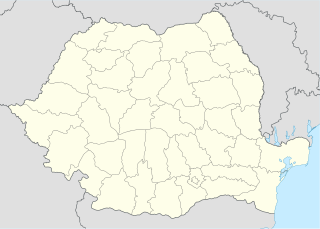Peştera Urşilor
| The Bear Cave from Chişcău (Peştera Urşilor)
|
||
|---|---|---|
|
Skeleton of a cave bear (Ursus spelaeus) in the cave |
||
| Location: | Pietroasa Municipality , Chișcău Village, Bihor County , Romania | |
| Height : | 470 m | |
|
Geographic location: |
46 ° 33 '14 " N , 22 ° 34' 9" E | |
|
|
||
| Type: | Stalactite cave | |
| Lighting: | Effect lighting available | |
| Overall length: | 1009 m | |
| Length of the show cave area: |
488 m | |
| Particularities: | Bear skeleton and stalactite galleries. | |
Peştera Urşilor ( German Bear Cave ) is one of the most famous caves in Romania and is located in the Kreisch area , in the west of Transylvania , about 75 kilometers southeast of the district town of Oradea in the Bihor district near the municipality of Pietroasa , district of Chişcău.
cave
The cave is a commercial tourist attraction and has been attracting people from all over the world since it was opened in July 1980. It consists of three galleries, one on top of the other, of which only the top one has been prepared as a show cave . The two lower galleries are reserved for scientific research.
The cave shows a stalactite world that is impressive in its beauty and variety of shapes. However, the highlight of every tour is a visit to a fossilized skeleton of a cave bear ( Ursus spelaeus ). This skeleton is completely preserved and has been there for about 15,000 years.
The Bear Cave from Chişcău, Bihor County, was discovered by accident in 1975. As a result of local mine exploration, the opening to the underground level was created by blasting the entrance. The miner Traian Curta was the one who climbed into this cave first, he went through the gallery to the great hall of the cave. This was followed by new explorations of the cave by the group of speleology amateurs Speodava from Ştei, then by the specialists from the Emil Racoviţă Institute of Speleology , in collaboration with the representatives of the riării Crişurilor Museum from Oradea. In 1980, after five years of exploration and establishment, the bear den was opened for visits. The Bear Cave consists of four main galleries: Galeria Oaselor (The Gallery of Bones), the Emil Racoviţă Gallery, Galeria Lumânărilor (the Gallery of Candles) and the Galeria Ştiinţifică (Scientific Gallery). The access to the scientific gallery, located in continuation of the Emil Racoviţă gallery and accessible only through a 30 m shaft, is intended for professional specologists. In the three main galleries of the bear cave, which are open to the public, you can discover the remains of the cave bear through a large number of fossils that gave the cave its name, but also various impressive formations such as stalactites and stalagmites; some of them were also given names for their features, such as: Palatul Fermecat (the enchanted palace), Căsuţa Piticilor (the house of the dwarfs), Lacul cu Nuferi (the lake with the water lilies), Sfatul Bătrânilor (the council of the ancients) and so on.
The cave was discovered during quarrying and reported to the Emil Racoviță Institute for Speleology. It was placed under nature protection.
The show cave can be entered without restrictions or technical aids. The tour takes place in the sections
- Galeria "Urșilor" ( Bear Gallery )
- Galeria "Emil Racoviță" (Gallery of Emil Racoviță , tribute to an important Romanian cave explorer)
- Galeria "Lumânărilor" (wax candle gallery )
- Sala Lumânărilor (Hall of the wax candle stalactites)
- Sala Spaghetelor (room of spaghetti stalactites)
- Sala Oaselor (Hall of Bones) with the bear skeleton
Photo gallery
See also
Individual evidence
Web links
- The Bear Cave from Chişcău , official website of the cave (German)
- Peştera Urşilor , site of the cave (Romanian)
- Ursilor Cave , description of the cave (English) on website http://www.welcometoromania.ro/ (Romanian)
- Oradea University: Peștera Urșilor (English)
- Pestera-ursilor : Detailed description on the website of the "Pension Maria" at the Bear Cave in the village of Chiscau. (Romanian)
- Pestera Ursilor , description of the bear cave (Romanian)





